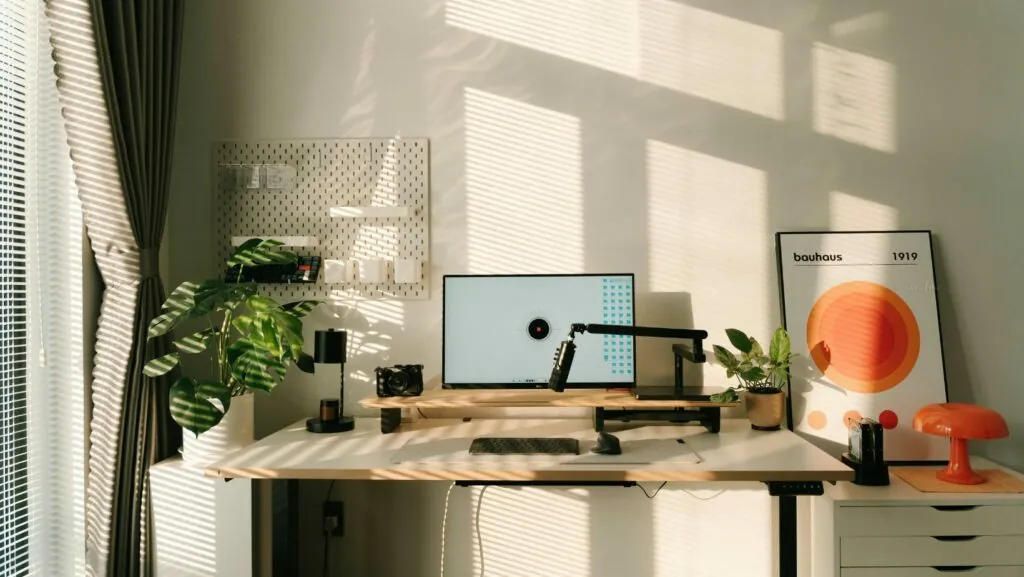Table of Contents
ToggleThe best workspace isn’t the one with the prettiest gear; it’s the one you can use for hours without a stiff neck or a sore lower back. An electric frame lets the desk meet your body instead of the other way around. You sit with feet planted, wrists straight, shoulders relaxed; then, at the press of a button, you stand and keep the same alignment. That simple shift does more for focus than any new app because your posture stops fighting your attention. You start and end the day with the same calm shape, and creative work – writing, editing, planning – feels less like a grind and more like a flow you can return to.
If you’re weighing options and want a clean starting point for sizes and styles, browse an electric standing desk range and look for two things: a quiet lift that doesn’t wobble mid-motion, and memory presets you’ll actually use. Set one height for deep, seated sessions and one for calls or light admin when standing. Two honest presets beat ten you’ll forget, and that little bit of consistency is what turns a nice desk into a habit that sticks.
Small rooms, big returns
Apartments, spare bedrooms, and rehearsal corners don’t forgive wasted space. A good frame makes tight rooms feel larger because you can hold screen and keyboard where your hands and eyes want them, not where a fixed table traps them. Depth matters here: bring the top close enough to rest your forearms without hunching, but far enough to keep the screen at an easy read. When you stand, you keep that triangle – eyes, hands, screen – steady, so your body isn’t relearning the layout every hour. The room doesn’t change, yet it breathes better because you aren’t twisting around a bad height or a long reach.
Clarity shows up in daily rhythm too. Standing for a quick call, dropping back to polish a paragraph, then taking five minutes to stretch is easier when the surface moves smoothly. You stop saving posture “fixes” for the weekend. The frame turns into part of how you think, not a gadget you feel guilty for ignoring.
The right frame beats a big top
A wide slab without a stable base is a pretty frustration. What carries the day is a frame that lifts quietly, resists shake, and holds its heights without drift. That keeps cameras steady on video and stops micro-wobbles from creeping into your shoulders while you type. If you’re planning to reuse a favorite tabletop or adjust the footprint later, pick a base first and let the surface follow. When you’re comparing options, it helps to check out the standing desk frame category and match three things to your room: width range that fits the wall you own, lift span that covers both sneakers and dress shoes, and feet that sit flat on your floor without shims. Get those right and the top you choose will feel like it belongs there rather than hovering awkwardly.
A good frame also forgives real life. It should start and stop without a jolt, remember heights even after a power blink, and give you controls you can hit without looking. That’s the difference between “fancy furniture” and a tool you trust when the day gets busy.
One tidy list to keep cables, light, and sound under control

- Route power to a single under-desk strip on the outlet side; one heavy cord goes to the wall
- Leave a soft loop where the desk moves, so plugs never pull when you stand
- Keep a vented stand under the laptop to cut fan noise during heavy sessions
- Bounce a lamp off the wall behind your screen for softer light on video calls
- Park a microfiber cloth in the top drawer and wipe the screen once a week
These tiny moves make the lift feel invisible. No snags when you change height, no glare that tires your eyes, no hum from the back edge kissing the wall. The desk fades and your work shows up.
A pace you can actually maintain
The trick isn’t to stand all day; it’s to move on purpose. Use your presets to mark the day’s beats: seated for focused writing, standing for reviews or calls, a short stretch between tasks. If you share the space, give the other person a preset with their name and stop guessing mid-meeting. Put the things you touch hourly – notes, pen, headphones – on the non-mouse side so your main zone stays open. If a bin lives under the desk, add sliders so it glides out with one hand; little frictions are the ones that make you give up a new routine.
On Fridays, reset the room in two minutes: square the keyboard to the screen, coil the one cable that drifted, and clear the corner where mugs collect. Monday will thank you. A frame that helps these tiny rituals is doing more than lifting wood; it’s keeping your week from unraveling.
Buy once, adapt often
Work changes – more calls, a second monitor, a new laptop with different ports. A solid frame lets the rest of the setup evolve without drama. Add an arm when you’re ready, swap a top if the room changes, shift heights as your shoes do. You’re not chasing the newest thing; you’re keeping the space honest to how you work now. That’s the quiet promise of a good electric base: it won’t shout for attention, but it will give you a desk you can trust on the days that ask the most. And when the furniture disappears and the hours feel smoother, you’ll know you picked well.







